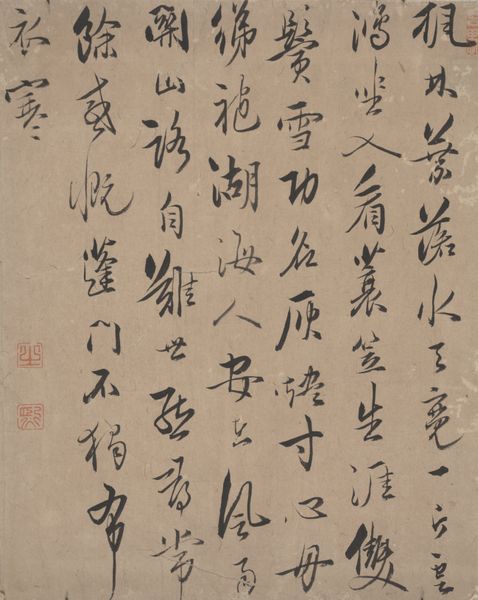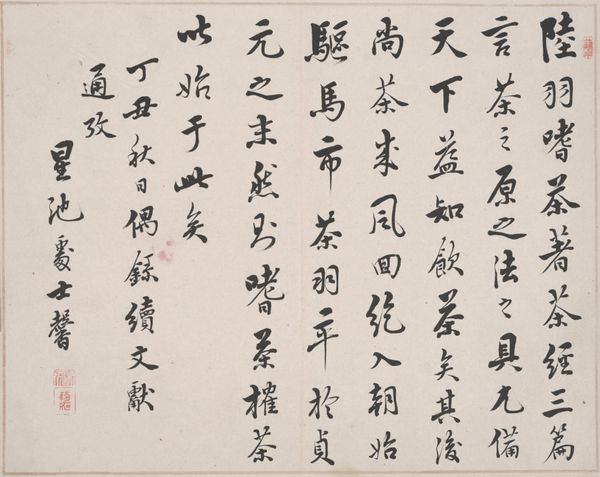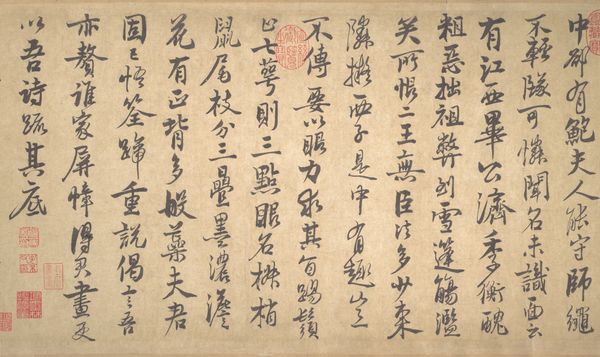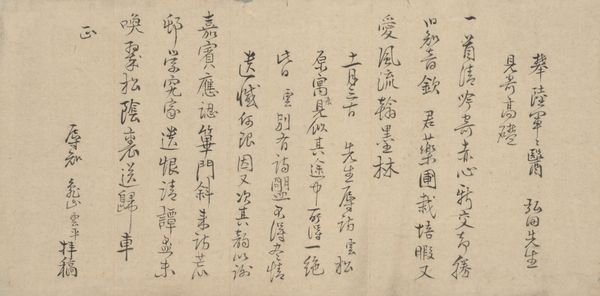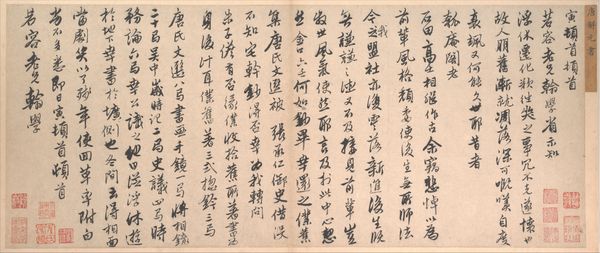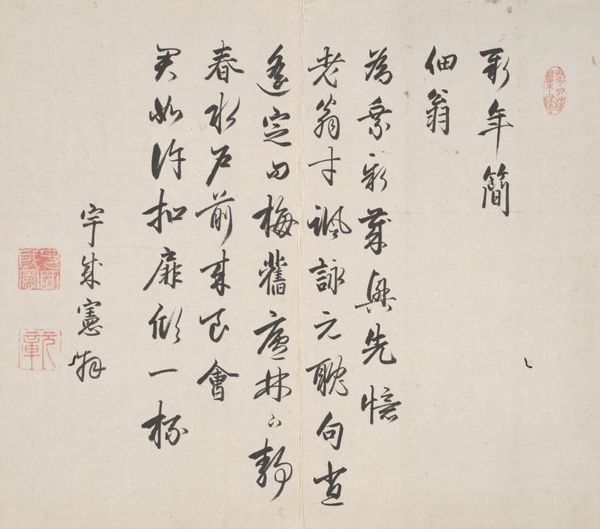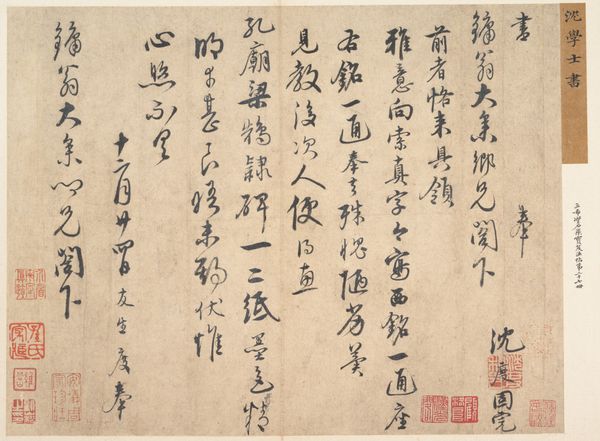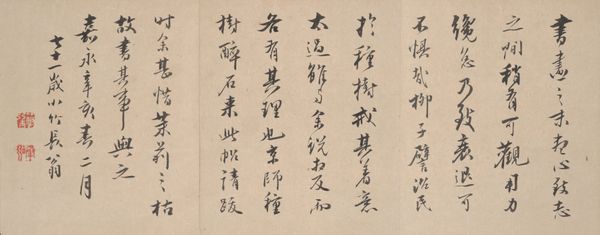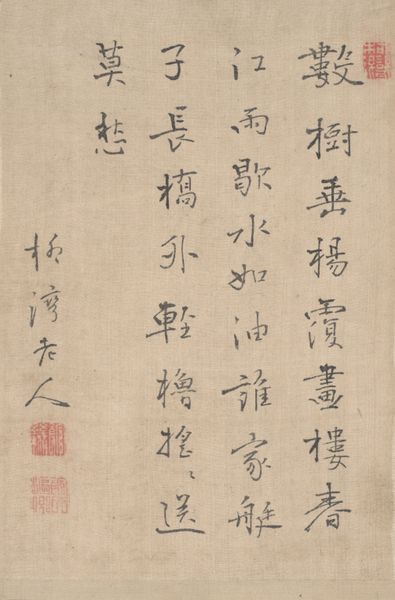
drawing, paper, ink
#
drawing
#
asian-art
#
paper
#
ink
#
calligraphy
Dimensions: 7 13/16 × 9 3/4 in. (19.84 × 24.77 cm) (image)37 5/8 × 11 3/8 in. (95.57 × 28.89 cm) (mount, without roller)
Copyright: Public Domain
Curator: Welcome. We are looking at a piece of calligraphy titled “Draft in Regular Script” by Tanomura Chikuden, created sometime between 1817 and 1835. It’s ink on paper. Editor: My initial impression is one of quietude. The dark ink against the paper creates a striking contrast, yet there's an undeniable feeling of spaciousness—almost meditative, isn’t it? Curator: Indeed. Beyond the visual aesthetic, let’s consider the historical backdrop. Chikuden lived through a period of great social and political upheaval in Japan. His art, particularly his calligraphy, reflects a turn inward, toward personal expression and the literati tradition, which valued scholarship, poetry, and the arts as a form of resistance against the dominant political powers. Editor: I’m struck by the rhythm of the characters themselves. See how the varying thicknesses and shapes create a sort of visual melody? The ink seems to dance across the surface, echoing the poem’s theme. Curator: Absolutely. The content likely reflects a yearning for escape from social norms, aligning with the ideals of like-minded individuals devoted to personal cultivation in times of crisis. I appreciate your interpretation of its melody, especially since the literary world and writing have historically been dominated by males. What impact did Chikuden's role have in shifting dynamics, giving new means to artistic expression and historical reflection? Editor: It’s an interesting counterpoint. Do you think his style and character placement alludes to his desire to separate and distinguish from the current aesthetic? Curator: That's insightful. I would argue that Chikuden leverages his position in society to provide commentary through art. But looking at how he balances elements and leverages asymmetry leads to greater conversations about breaking down binaries and expectations. It shows his commentary on art through material, presentation, and message. Editor: Thank you. Looking closely and layering the history does make this artwork feel richer.
Comments
minneapolisinstituteofart almost 2 years ago
⋮
Carefully rendered in standard script, this draft of an essay discusses Tanomura’s yearning for a life away from the urban setting, like that of Chinese hermits. He came from a family of physicians who had served the lord of Oka domain (modern-day Ōita prefecture on the island of Kyūshū), but he eventually abandoned the hereditaryoccupation to pursue life as a scholar and painter. This work includes punctuation marks, which is often omitted in other calligraphic works in this gallery: small circles function as commas or periods.人言市上藏山。池園此地看來是。花垂豆架。葉翻芋圃。巷幽途細。有個柴門。竹扉半扇。日高猶閉。覺眼前清曠。襟懐開朗。人兼地俱瀟酒蒔草移花隨意。向林間。沾々偏喜。醒時喚酒。醉時呼茗。每朝聊爾。藥譜農書。孝經論語。略存經濟。對清風。一笑。平泉金谷。不關吾事右水龍吟People say there is a mountain hidden in the urban hustleand bustle. It looks like this pond garden is the place.Flowers draping down on the bean stands; leaves flippingover yam fields. The alley is tranquil and the trail narrow.There is a wooden gate with a half bamboo door. The doorremains closed when the sun is high. A crisp and transparent feeling unfolds before my eye, and my chest clearsup. This place and I are both free of care. Seasonal grassesand transplanted flowers freely thrive. Toward the woods, Iam delighted. Calling for wine when awake and requestingtea when tipsy. Every day I discuss medicinal albums, agricultural books, the Classic of Filial Pity, and the Analects;sometimes on governance and statecraft. A smile at thebrisk breeze.Pingquan and Jingu [symbols of secular wealth and power]are not relevant to me.The right composed by Suiryūgin
Join the conversation
Join millions of artists and users on Artera today and experience the ultimate creative platform.

